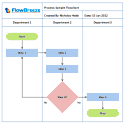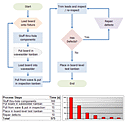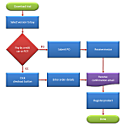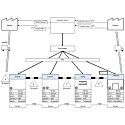How to Create a Flowchart in Microsoft Word 2007 - 2019
By Nicholas Hebb
This article shows the process of creating a flowchart in Microsoft Word. Of the standard Microsoft Office applications - Excel Word, PowerPoint - Excel is the most powerful and user friendly for creating flowcharts (disclosure: we make a flowchart automation add-in for Excel), but in some cases creating flowcharts in Word is handy. This isn't a step-by-step tutorial, but it does try to give a useful overview of the Drawing tools in Word, as well as offer some tips and highlight a few quirks.
Excel Flowchart Wizard
FlowBreeze is a flowchart add-in for Microsoft Excel that makes creating flowcharts simple and pain free. Free 30-Day Trial.Note on Ribbon (Toolbar) Controls
You may want to maximize Word to full screen when using this tutorial. The ribbon takes a lot of screen space, and some of the controls referenced in this article may be hidden if the window is not maximized.
The next two section reference the image on the right. The screenshot is from Word 2013, but the following steps have remained consistent from Word 2007 through Word 2019.
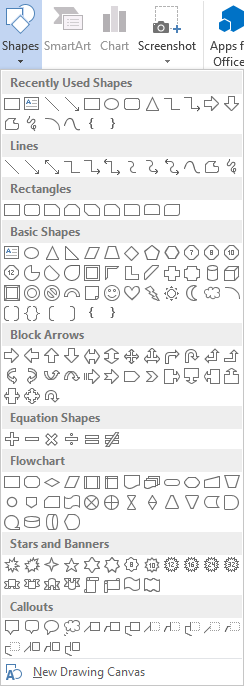
Insert canvas and shapes
Insert a Canvas
Word flowcharts are best contained within a Drawing Canvas. You can insert shapes directly into a Word document, but using a canvas has several advantages:
- They act as a container for the shapes, making it easier to position (or re-position) a flowchart in a document.
- Certain features, like arrows that connect to shapes, only work in a canvas.
- You can add formatting to the canvas itself, giving the flowchart an attractive backdrop.
To insert a canvas, click the Insert tab on the Word ribbon and click the Shapes dropdown button. Below the gallery of shape types, select the bottom menu item labeled New Drawing Canvas, as shown to the right. Side note: If you are using a laptop with a glossy monitor, the canvas border can be difficult to see when viewed at a slight angle.
Adding a Flowchart Shape
Adding shapes is pretty straightforward:
- Click the Insert tab on the ribbon.
- Click the Shapes dropdown.
- Click on the shape type you want to add.
- Click in the canvas area, holding the left button down while dragging the mouse to add the shape.
You can also double-click on any shape in the gallery, and Word will add it to the top left of the canvas. Typically you will need to move and resize the shape if you use this method.
Displaying a Grid
Grids let you layout shapes to uniform widths and heights, as well as making it easier to align shapes if you need to edit a flowchart and move things around. Not only is the grid a visual indicator, but it also has a snap function that assists with alignment and sizing.
A quick way to enable a grid is to click the View tab and click the Gridlines checkbox. With enabled gridlines, the grid will appear only within the canvas (which we'll get to next) when it is selected, but when any other part of the Word document outside the canvas is selected, the grid will be displayed over the entire document.
For more precise control of the gridlines, you can customize settings in the Grid and Guides screen, shown in the images below. Generally the default settings are sufficient, but checking the "Snap objects to grid when gridlines are not displayed" box is useful if you want the snap behavior without having gridlines cover the entire document. As shown below-right, a "Display alignment guides" option was added to this dialog. When checked the gridlines are not shown, so personally I do not find this option useful.
To access the Drawing Grid screen, follow these steps:
- Click on the drawing canvas.
- Click on the Drawing Tools Format tab that appears.
- Click the Align dropdown menu and select Grid Settings.
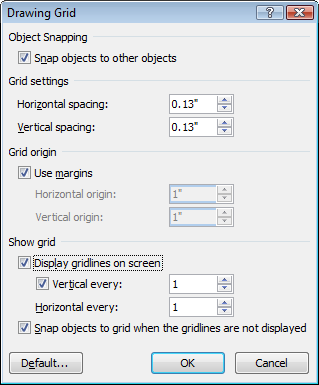
Grid and Guides Dialog - Word 2007
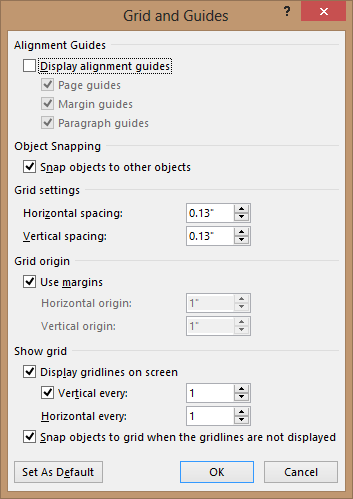
Grid and Guides Dialog - Word 2013
Adding Text to a Flowchart Shape
In Word 2007, if you click on a shape and start typing, you will soon find out that text is added somewhere in the main document body instead of within the shape. In order to add text, you need to right-click on the shape and select "Add Text" from the context menu. Once a shape contains text, you can click the text and edit it normally.
In Word 2010 - 2019, by contrast, you can simply click on the shape and start typing.
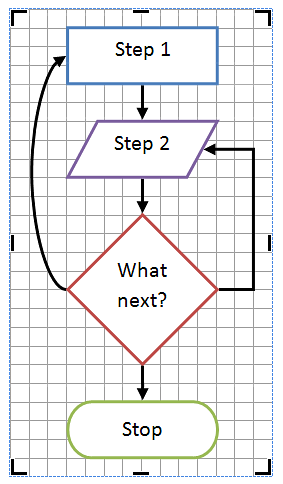
Adding Connector Arrows
Connectors are different from plain arrows in that they stay connected to shapes if they are moved. Assuming you want to route a connector line between two shapes, we will call these Shape 1 and Shape 2 below.
- Click the Insert tab.
- Click the Shapes dropdown
- Click the desired line type from the gallery.
- Move your mouse near Shape 1 and little dots denoting connection points will appear on its border.
- Click on one of the dots and, while holding the left mouse button down, move the mouse over to Shape 2.
- As you move the mouse over Shape 2, Word will highlight connection points and display a dashed line showing the routing.
- Select one of the connection points and release the left mouse button.
Quirk: In Word 2007 and previous versions, the elbow connector would render as a straight line between two aligned shapes of the same size. In Word 2010, the same elbow connectors render slightly jagged and unaesthetic.
Tip: Right-click on a connector to change the connector type via the context menu. The three types are straight, elbow, and curved, as shown in the sample flowchart.
Adding Labels
To add branch labels next to connector lines, use the textbox symbol ![]() on the Insert > Shapes gallery. After inserting the textbox (label), type in the text. Click the Home tab in Word and format the text as needed. The easiest way to adjust the size is to click and drag the adjustment handles on the texbox edges. With the textbox still selected, click the Format tab, and then select the Shape outline drop down and toggle on the No Outline option for a cleaner look.
on the Insert > Shapes gallery. After inserting the textbox (label), type in the text. Click the Home tab in Word and format the text as needed. The easiest way to adjust the size is to click and drag the adjustment handles on the texbox edges. With the textbox still selected, click the Format tab, and then select the Shape outline drop down and toggle on the No Outline option for a cleaner look.
Adding labels is a multi-step process, so when adding more labels it's usually easiest to copy and paste the first label and edit the text accordingly.
Selecting Multiple Shapes
There are several ways to select multiple objects. One method is to click on one shape, hold the Shift key down, and click on the remaining shapes. Another method is to click and drag your mouse around all the shapes you want to select. This is faster, but sometimes less useful if, for example, you want to select the flowchart shapes without selecting the connector arrows.
Two non-recommended methods that you may be familiar with are Select All and Select Objects. These tools are commonly used in Excel and other Office programs, but they are not as useful in Word. In Excel, for example, Select All will select only the shapes on a worksheet, but in Word, it will select the entire document. The Select Objects tool is a special cursor that allows you to click on the shapes instead of the text, and does not add any value above selecting them with the regular mouse cursor. Plus, you need to toggle it off in order to resume normal Word operations.
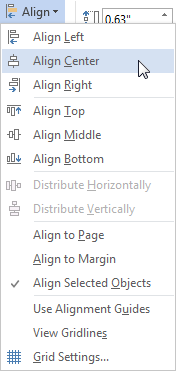
Align shapes menu
Aligning Shapes
With the grid enabled, the easiest way to keep shapes aligned is to draw them with uniform widths at the time they are added to the diagram. If you need to edit the alignment after the fact, you can use several approaches. The first approach is to click on each shape and drag it to its new location. (If you need to resize the shape to get it aligned properly, see the next section.)
The next approach is to select all the shapes you want to align, which will cause Word to display the Format tab. On the Format tab, click the Align dropdown menu, shown below. Making sure the Align Selected Objects item is checked, you can then use the alignment tool to align the shapes automatically.
Moving Shapes
The most obvious way to move shapes is to click and drag them to a new position. With the grid enabled, you can also move one or more selected shapes using the keyboard arrow keys and they will snap to the nearest gridline. You can nudge a shape by holding the Ctrl key down while pressing the keyboard arrow keys.
Resizing and Rotating Shapes
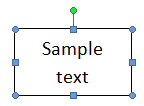
If you click on a shape, resize handles appear on the shape’s border, allowing you to click and drag a side or corner, as shown in the image. The green dot at top is the rotation adjustment handle.
Alternately, you can right-click on the shape and select "Format AutoShape" from the context menu. Clicking the Size tab on the Format AutoShape window will allow you to set the height, width and rotation angle to specific values.
Formatting Tips
Formatting shapes and connectors can be tedious if you try to do them one at a time. It is best to wait until you are finished with the flowchart and do the formatting in bulk. You can do this by selecting multiple shapes and formatting them together. You should format shapes and connectors separately because the styling tools are different for each.
If you have a format that you would like to reuse, you can right-click on a formatted shape and select "Set Autoshape Defaults". Any shape added subsequently will have the same fill color and border style.
When you select a shape or connector in Work 2007, a Format tab will appear on the ribbon, but you need to click to activate it. In Word 2010, the Format tab is automatically activated.
Quirk: Word 2007 has two format tabs – Drawing Tools Format and Text Box Tools Format. They are mostly the same. Word displays the Text Box Tools Format tab when the selected shape contains text and the Drawing Tools Format tab for all other shapes. In fact, if you add a flowchart shape to a drawing, selecting it will make the Drawing Tools Format tab appear, but once you add text to the shape, the Text Box Tools Format tab will appear. Fortunately, Word 2010 has only one Format tab.
Formatting Shapes
The formatting tools are located on the Format tab in Word 2007 and 2010. Starting in Word 2013, the formatting dialog has been replaced with side panels, and the Shape Fill and Shape Outline menus are disabled on the Format ribbon tab. Instead, you can access them by right-clicking on a shape.
There are too many formatting tools to cover them all in detail, but the primary ones are covered below.
Shape Styles: The style gallery allows you to apply formatting to one or more selected shapes. There is a significant difference between Word 2007 and 2010. Word 2007 has a larger selection of styles, but they are not consistent with the Excel 2007 shape styles. Starting with Word 2010, the styles are uniform across all Office appslication - Word, Excel, and PowerPoint.
Shape Fill: Allows you to set custom fill colors and gradients for the shapes.
Shape Outlines: Allows you to set the line color and weight (thickness) of a shape's borders.
Change Shape: Allows you to change the type of the selected shape, e.g. from a process (rectangle) shape to a decision (diamond).
Tip: To access more formatting features (including vertical text alignment), right-click on a shape and select Format AutoShape.
Formatting Connectors
Word 2007: There is a gallery of styles available, but unfortunately, these are the styles used for flowchart shapes and do not work well for lines. To format connectors, you should use the color and weight settings available in the Shape Outline dropdown menu.
Word 2010 - 2019: Formatting connectors in Word 2010 - 2016 is straightforward. Just as with flowchart shapes, when you click a connector, the Format tab will be active, and a list of built-in styles is available for quick selection. Unlike Word 2007, the styles in Word 2010 - 2019 are actually attractive.
Formatting and Aligning Text
The bad news about flowcharting in Word is that it can be difficult to customize the text formatting. Some changes can be done in bulk and some must be done one shape at a time.
- Font: The font family, size and attributes such as bold and italic can be set from the Home tab of Word. You can select multiple shapes and make the changes in bulk.
- Color: The font color is set on the Home tab, and it must be done one shape at a time.
- Horizontal text alignment: The horizontal alignment can be set on the Home tab, and it must be done one shape at a time.
- Vertical text alignment: Vertical text alignment can only be set in the Format AutoShape window, which is accessed via the context menu by right-clicking on a shape.
Note:In Word 2007, the default text alignment is top, left. In Word 2010, it is centered both horizontally and vertically.
Canvas Size and Alignment
When you are done with the flowchart your canvas may be much larger than the diagram. If you want to shrink the canvas to the minimum footprint, right-click on the canvas and select Fit from the context menu.
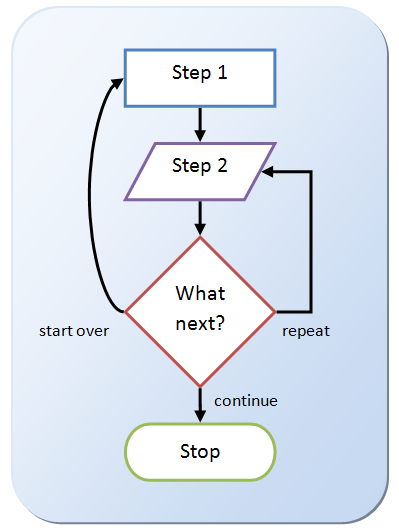
On the other hand, you may want the diagram centered on the page horizontally, vertically, or both. If so, follow these steps:
- (Optional) Resize the canvas to the page width and/or height by clicking and dragging the edges or corners.
- Next, select all the shapes in the flowchart, including the connectors.
- On the Format tab, click the Group dropdown and select Group from the menu.
- Click the Align dropdown and verify that the Align to Margin item is checked.
- In the Align dropdown again, click Align Center and/or Align Middle.
- Click the Group dropdown and select Ungroup from the menu.
If you don't Group the shapes before doing the alignment, the shapes will stack on top of each in the center of the canvas.
Finally, you can spruce up the flowchart a bit by adding formatting to the canvas. The Canvas shape itself can be changed - just like a flowchart shape - using the tools on the Format tab. In the sample flowchart above, the Change Shape tool was used to set the shape type to Alternate Process, which makes it a rounded rectangle. A custom fill color with a gradient scheme was applied. Finally, the Drop Shadow tool was used to add depth.
Summary of Quirks
- If you do not use a canvas, connectors will not "connect".
- You can copy a flowchart from Word (2007 - 2019) and Paste Special into Excel as an editable Microsoft Office Drawing Object, but you cannot copy a flowchart from Excel and Paste Special into Word as an editable drawing. Earlier versions of Word (2003 and prior) used to allow this.
- If you Group all the shapes within a canvas, the Fit feature is disabled. If you ungroup the shapes, then right-click on the canvas again, the Fit feature is re-enabled.
- Using Page Layout > Themes to change the document formatting will change the flowchart styling as well, even if you carefully customized the formatting of all your shapes.
- Using View > Gridlines will display a grid not only in the canvas, but also over the entire document and any other open document as well. When the canvas is selected, the grid will only be displayed within the canvas. The quirk is that if you apply a background style to the canvas, the grid will not display in the canvas - perhaps the one place you did want it to show.
- Word 2007 introduced vertical text alignment (it was not available in Word 2003 and previous versions), but centered text is skewed toward the top of the shape and the difference between it and top aligned text is barely noticably. You can set this in the Format AutoShape screen.
- The Format AutoShape dialog has a "Resize AutoShape to fit text" option. If you use it, remember that Word has an Undo function. You might need it.
About the Author
Nicholas Hebb
Nicholas Hebb is the owner and developer of BreezeTree Software, makers of FlowBreeze Flowchart Software, a text-to-flowchart maker, and Spreadspeed, an auditing and productivity toolset for Microsoft Excel®.
